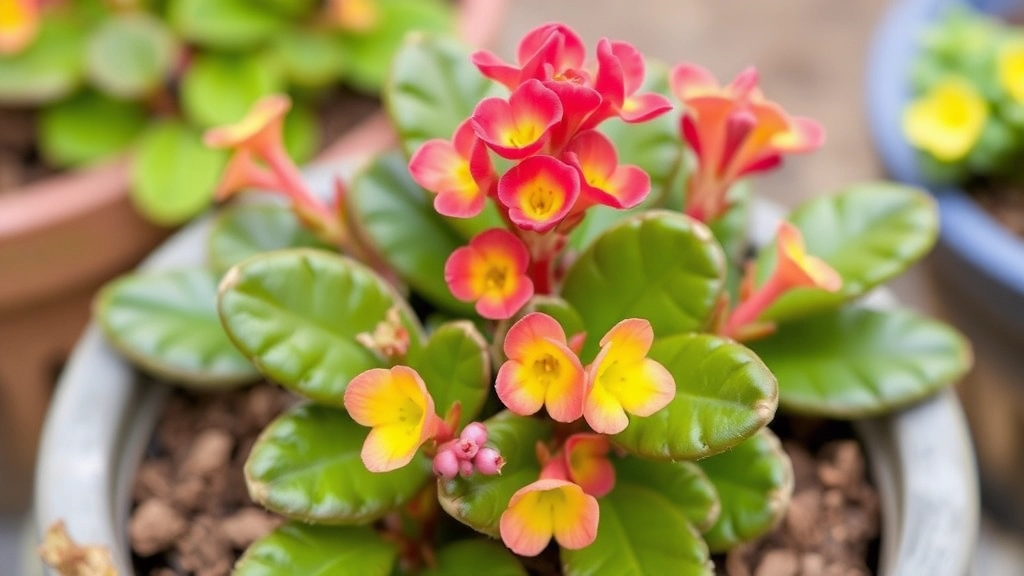Flowering Kalanchoe Care
Light Conditions
When it comes to Flowering Kalanchoe care, I’ve found that getting the light conditions just right is crucial. These vibrant succulents thrive in bright, indirect sunlight, making a sunny windowsill the perfect spot. Too much direct sun can scorch the leaves, while too little light can hinder blooming. Balancing this light exposure ensures your kalanchoe remains healthy and full of vibrant flowers.
Watering
Watering your Flowering Kalanchoe properly is the next big step. Overwatering is a common mistake that leads to root rot. I water mine thoroughly but let the soil dry out completely between waterings. This schedule mimics their natural environment and keeps the roots healthy. Remember, it’s better to underwater than overwater with these resilient plants.
Optimal Light Conditions for Flowering Kalanchoe
Are you struggling to get your Kalanchoe to bloom?
Light plays a pivotal role in the flowering process of this stunning succulent.
To ensure your Kalanchoe thrives and produces vibrant flowers, consider the following optimal light conditions:
- Bright, Indirect Light: Kalanchoe prefers bright, indirect sunlight. A south or west-facing window is ideal, providing ample light without the harshness of direct sun.
- Duration: Aim for around 12 to 14 hours of light each day. This can be achieved through natural light or supplemented with grow lights if necessary.
- Avoid Overexposure: Too much direct sunlight can scorch the leaves, leading to damage. If you notice browning edges, it’s time to move your plant to a shadier spot. For more details on this, check out our guide on causes and solutions for brown spots on Kalanchoe leaves.
- Seasonal Adjustments: As seasons change, so do light needs. In winter, ensure your Kalanchoe receives enough light by rotating it regularly to prevent uneven growth.
- Signs of Insufficient Light: If your Kalanchoe is stretching towards the light or producing fewer flowers, it may be a sign it needs more exposure. For more in-depth care tips, visit our top flowering Kalanchoe species and care tips page.
By understanding these light requirements, you can create a flourishing environment for your Kalanchoe to bloom beautifully.
Watering Guidelines to Prevent Root Rot
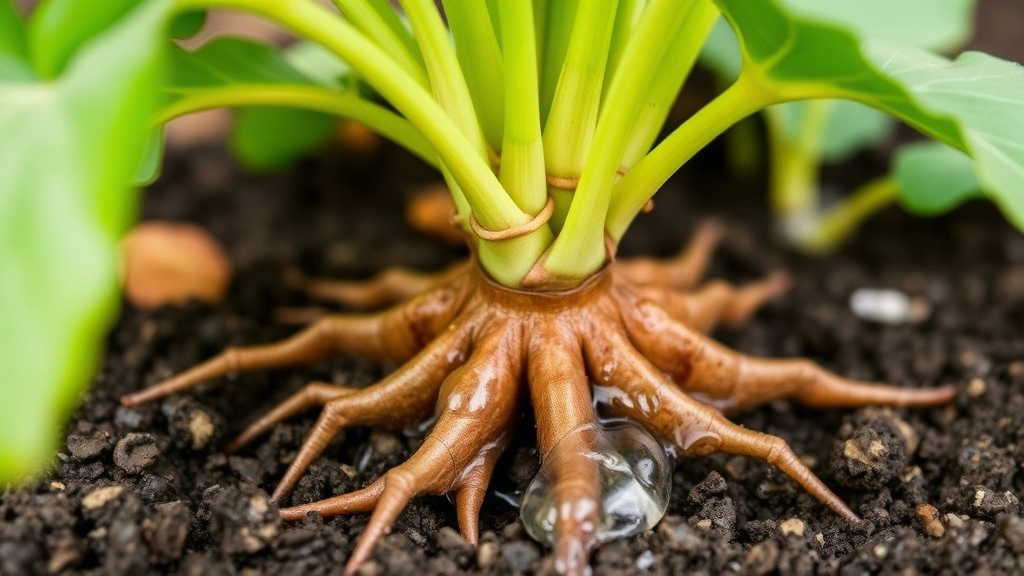
So, you’ve got your Kalanchoe thriving under those optimal light conditions, but now you’re wondering: how do I keep it alive without drowning it?
Watering Basics
First off, Kalanchoes are succulents, and they absolutely hate sitting in soggy soil. Here’s how to keep your plant happy and healthy:
- Check the Soil: Before watering, stick your finger about an inch into the soil. If it feels dry, it’s time for a drink. If it’s still moist, hold off for a bit.
- Watering Technique: When you do water, do it thoroughly. Give it a good soak until water drains from the bottom of the pot. This ensures the roots get enough moisture without sitting in it.
- Frequency: Generally, watering every 2-3 weeks is a safe bet. But remember, it can vary depending on the season and humidity levels.
- Pot Choice: Use pots with drainage holes. This is a game changer for preventing root rot.
Signs of Overwatering
Keep an eye out for these red flags:
- Yellowing leaves? That could mean too much water.
- Mushy stems? Definitely a sign of root rot.
If you spot these issues, it’s time to reassess your watering routine.
Seasonal Adjustments
In winter, your Kalanchoe will need less water since it’s not actively growing. Adjust your schedule accordingly.
Temperature and Humidity Preferences
Are you struggling to keep your Kalanchoe thriving? One often overlooked aspect is the temperature and humidity in which these plants flourish. Understanding their preferences can make all the difference in achieving vibrant blooms.
Ideal Temperature Range
Kalanchoe plants prefer a warm environment. Here’s what you need to know:
- Daytime Temperature: Aim for 20-25°C (68-77°F).
- Nighttime Temperature: A slight drop to 15-18°C (59-64°F) is ideal.
Maintaining these temperatures helps your Kalanchoe remain healthy and encourages flowering.
Humidity Levels
Kalanchoe thrives in moderate humidity. Here’s how to manage it:
- Optimal Humidity: 40-60% is perfect.
- Avoid Excess Moisture: High humidity can lead to fungal issues.
If your home is dry, especially in winter, consider using a humidifier or placing a tray of water near your plant. This can create a more suitable environment.
Seasonal Considerations
- Winter Care: During colder months, ensure your Kalanchoe is away from drafts and heating vents to prevent temperature fluctuations.
- Summer Care: In warmer months, you might need to provide some shade to prevent leaf scorch.
By keeping an eye on temperature and humidity, you’ll set your Kalanchoe up for success. For more specific guidance, check out our Mother of Millions care guide and our detailed tips on Kalanchoe blossfeldiana flowering period care.
Soil Composition and Repotting Best Practices
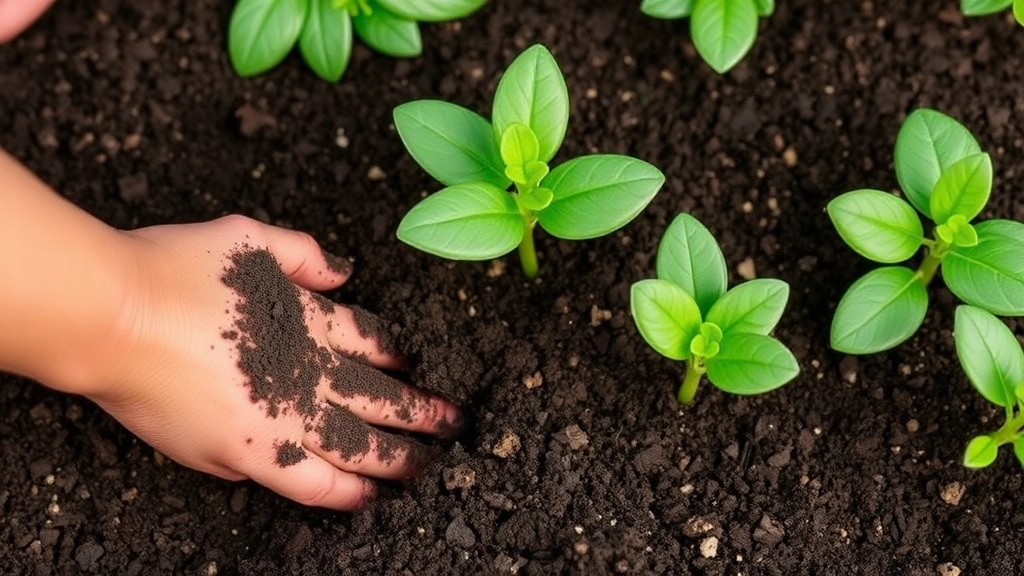
When it comes to nurturing your Kalanchoe, the right soil composition is crucial for promoting healthy growth and vibrant blooms. Many plant enthusiasts often worry about whether they are using the right mix or if their plant needs repotting. Let’s explore how to ensure your Kalanchoe thrives.
Optimal Soil Composition
Kalanchoe plants prefer well-draining soil that allows for proper aeration and prevents water retention. Here are some key components to consider:
- Cactus Mix: A commercial cactus mix is an excellent choice as it provides the drainage Kalanchoe needs.
- Perlite or Pumice: Adding perlite or pumice to your soil mix enhances aeration and drainage. Aim for a ratio of 2:1 soil to perlite.
- Organic Matter: Incorporating some organic matter, like compost, can provide essential nutrients while still maintaining drainage.
Repotting Best Practices
Knowing when and how to repot your Kalanchoe can significantly impact its health. Here are some guidelines:
- Timing: Repot your Kalanchoe every 1-2 years or when you notice roots emerging from the drainage holes. Early spring is ideal for repotting as it aligns with the plant’s growing season.
- Container Choice: Choose a pot that is slightly larger than the current one, ensuring it has drainage holes to prevent water accumulation.
- Gentle Handling: When removing the plant from its pot, handle it carefully to avoid damaging the roots. Shake off excess soil gently.
- Soil Replacement: Use the recommended soil mix to fill in around the roots, ensuring the plant is at the same depth as it was in the previous pot.
Fertilization Tips for Abundant Blooms
Are you struggling to get your Kalanchoe to bloom abundantly?
Fertilization plays a crucial role in encouraging vibrant flowers and healthy growth.
Understanding Fertilizer Needs
Kalanchoe thrives on a balanced fertilization schedule.
Here are some key tips to ensure your plant flourishes:
- Choose the Right Fertilizer: Opt for a balanced, water-soluble fertiliser, preferably with an NPK ratio of 15-30-15. This promotes flowering while supporting overall plant health.
- Frequency: Fertilize every 4-6 weeks during the growing season (spring and summer). Reduce feeding in autumn and winter when the plant enters dormancy.
- Dilution: Always dilute your fertiliser to half the recommended strength. This prevents over-fertilization, which can harm your plant.
- Application Method: Apply fertiliser directly to the soil, avoiding contact with the leaves. This reduces the risk of leaf burn.
Signs of Nutrient Deficiency
Keep an eye out for signs that your Kalanchoe may need a nutrient boost:
Pruning Techniques to Encourage Reblooming
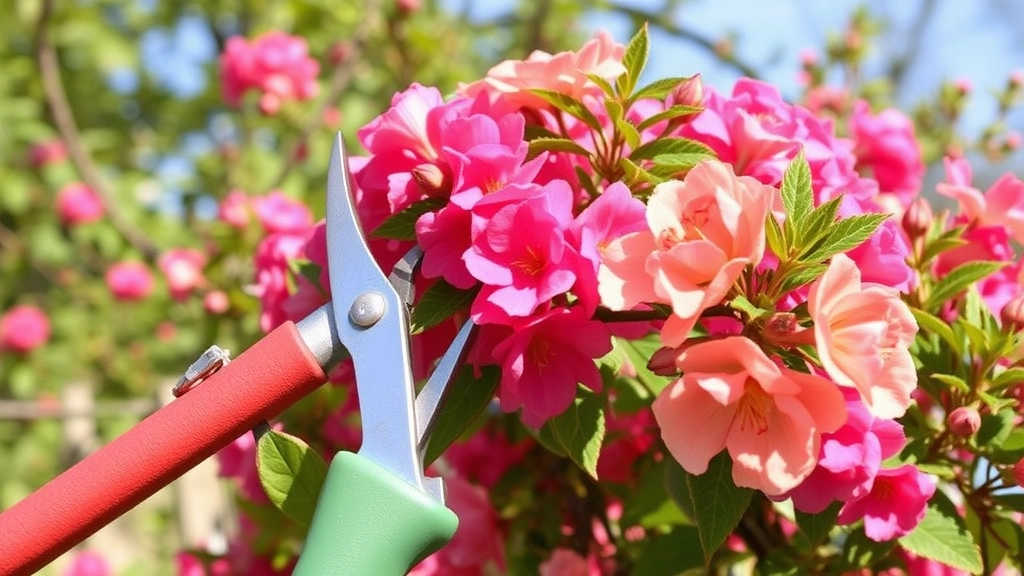
So, you’ve nurtured your Kalanchoe, and it’s blooming beautifully. But how do you keep those vibrant flowers coming back? Pruning is your best friend here!
Why Prune?
Pruning isn’t just about making your plant look tidy; it’s essential for encouraging new growth and blooms. You might be wondering:
- When should I prune?
- How much should I cut back?
Let’s break it down.
Pruning Steps
- Timing is Key
– Prune after the blooming period.
– This is usually in late spring to early summer. - Tools You’ll Need
– Sharp, clean scissors or pruning shears.
– A small pot for any cuttings you want to propagate. - What to Cut
– Remove spent flowers to promote new growth.
– Trim back any leggy stems to encourage bushier growth.
– Aim to cut just above a leaf node. - Technique
– Cut at a 45-degree angle.
– This helps prevent water from pooling on the cut surface, reducing the risk of rot. - Don’t Overdo It
– Aim to remove about one-third of the plant at most.
– Too much pruning can stress the plant.
Aftercare
Once you’ve pruned, give your Kalanchoe a little TLC:
- Water lightly to help it recover.
- Avoid direct sunlight for a few days to reduce stress.
Real Talk
I’ve seen my Kalanchoe bounce back beautifully after a good prune. It’s like giving it a fresh start!
Managing Common Pests and Diseases
As you nurture your Kalanchoe, you may encounter various pests and diseases that could hinder its growth and flowering.
Propagation Methods: Stem Cuttings and Division
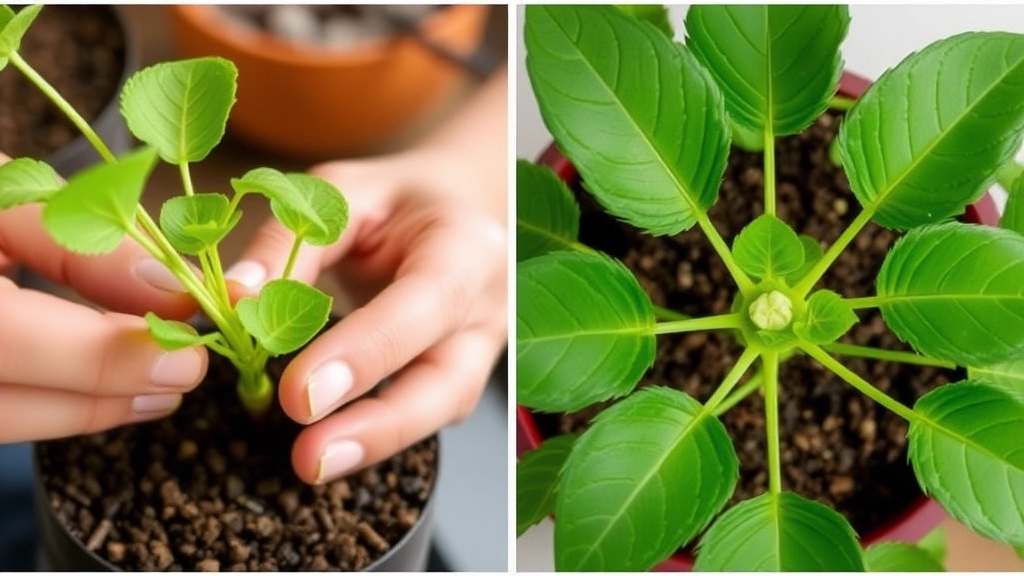
So, you’ve got a beautiful Kalanchoe and you’re thinking about spreading the love?
Propagation is a fantastic way to multiply your plants without breaking the bank.
Let’s dive into two popular methods: stem cuttings and division.
Stem Cuttings
This method is super straightforward and a great way to get new plants from your existing ones.
Here’s how to do it:
- Select a Healthy Stem: Look for a strong stem that’s at least a few inches long.
- Cut the Stem: Use clean, sharp scissors to snip just below a leaf node.
- Let it Callous: Place the cutting in a dry spot for a few hours or overnight. This helps prevent rot.
- Prepare the Pot: Fill a small pot with well-draining soil.
- Plant the Cutting: Stick the cutting into the soil, burying it about an inch deep.
- Water Sparingly: Give it a light watering, but don’t soak it. Too much moisture can lead to root rot.
- Provide Light: Place it in a bright spot but out of direct sunlight until it establishes roots.
Division
If your Kalanchoe is getting a bit crowded, dividing it can help both the plant and your collection.
Here’s a simple way to do it:
- Choose the Right Time: Spring is ideal for division when the plant is actively growing.
- Remove the Plant: Gently take the Kalanchoe out of its pot.
- Separate the Clumps: Use your hands or a clean knife to divide the root ball into smaller sections. Each section should have roots and a few leaves.
- Repot: Place each section into its own pot with fresh soil.
- Water Well: Give them a good drink, but let the excess drain out.
Both methods are rewarding and can lead to a thriving collection of Kalanchoe.
Seasonal Care: Preparing Kalanchoe for Winter Months
As we transition into the colder months, ensuring your Kalanchoe thrives during winter is essential. Many plant enthusiasts worry about how to keep their beloved succulents healthy when temperatures drop.
Understanding Winter Needs
Kalanchoe, known for its vibrant blooms, requires specific care as winter approaches. Here are some key considerations:
- Light Conditions:
- Ensure your Kalanchoe receives ample sunlight.
- A south-facing window is ideal, as it provides the most light during shorter days.
- Watering Adjustments:
- Reduce watering frequency.
- Allow the soil to dry out completely between waterings to prevent root rot.
- Temperature Control:
- Maintain indoor temperatures between 15°C and 21°C.
- Avoid placing your plant near drafts or heating vents.
- Humidity Levels:
- Kalanchoe prefers lower humidity, so keep it in a dry environment.
- If your home is humid, consider using a dehumidifier.
Soil and Fertilization
- Soil Composition:
- Ensure your Kalanchoe is potted in well-draining soil.
- A cactus mix or a blend of potting soil with sand works wonders.
- Fertilization:
- Hold off on fertilising during winter.
- Resume feeding in spring with a balanced fertiliser to encourage new growth.
Monitoring for Pests
- Inspect Regularly:
- Keep an eye out for common pests like mealybugs and aphids.
- If spotted, treat promptly with insecticidal soap or neem oil.
For more detailed care tips, check out our ultimate guide to Kalanchoe care and learn how to plant Kalanchoe in a pot effectively.
FAQs on Flowering Kalanchoe Care
How often should I water my Kalanchoe to prevent root rot?
Water your Kalanchoe every 2-3 weeks, ensuring the soil is dry about an inch deep before watering. Overwatering can lead to root rot, so always check the soil moisture first.
What type of soil is best for Kalanchoe plants?
Kalanchoe plants thrive in well-draining soil. A commercial cactus mix combined with perlite or pumice at a 2:1 ratio is ideal. Adding some organic matter like compost can also be beneficial.
When is the best time to repot my Kalanchoe?
Repot your Kalanchoe every 1-2 years or when you notice roots emerging from the drainage holes. Early spring is the optimal time as it aligns with the plant’s growing season.
How can I tell if I am overwatering my Kalanchoe?
Signs of overwatering include yellowing leaves and mushy stems. If you notice these symptoms, reassess your watering routine to prevent root rot.
What are the steps for pruning a Kalanchoe to encourage reblooming?
Prune after the blooming period, usually in late spring to early summer. Use sharp, clean scissors or pruning shears to remove spent flowers and trim back leggy stems. Cut just above a leaf node at a 45-degree angle, and avoid removing more than one-third of the plant.
How do I propagate Kalanchoe using stem cuttings?
Select a healthy stem and snip just below a leaf node. Let the cutting callous for a few hours, then plant it in well-draining soil. Water sparingly and place it in a bright spot out of direct sunlight until roots establish.
Can I divide my Kalanchoe if it becomes too crowded?
Yes, you can divide your Kalanchoe in spring when the plant is actively growing. Gently remove the plant from its pot, separate the root ball into smaller sections, and repot each section in fresh soil. Water well and ensure proper drainage.
What should I do after pruning my Kalanchoe?
After pruning, water the plant lightly and avoid direct sunlight for a few days to reduce stress. This helps the plant recover and encourages new growth.
What are the signs that my Kalanchoe needs repotting?
If you notice roots emerging from the drainage holes or the plant appears to be outgrowing its current pot, it’s time to repot your Kalanchoe.
How can I ensure my Kalanchoe blooms again?
Proper pruning after the blooming period, adequate watering, and ensuring the plant receives enough light are key to encouraging reblooming in Kalanchoe.
References
-
Kalanchoe Plant Care: Tips For Growing Kalanchoe Plants
-
How to Grow Kalanchoe Indoors
-
Kalanchoe: How to Grow and Care for Kalanchoe Plants
